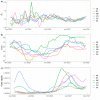Effectiveness of non-pharmaceutical interventions to reduce SARS-CoV-2 transmission in Canada and their association with COVID-19 hospitalization rates
- PMID: 38162959
- PMCID: PMC10756332
Effectiveness of non-pharmaceutical interventions to reduce SARS-CoV-2 transmission in Canada and their association with COVID-19 hospitalization rates
Abstract
Background: Non-pharmaceutical interventions (NPIs) aim to reduce the incidence of severe acute respiratory syndrome coronavirus 2 (SARS-CoV-2) infections mostly by limiting contacts between people where virus transmission can occur. However, NPIs limit social interactions and have negative impacts on economic, physical, mental and social well-being. It is, therefore, important to assess the impact of NPIs on reducing the number of coronavirus disease 2019 (COVID-19) cases and hospitalizations to justify their use.
Methods: Dynamic regression models accounting for autocorrelation in time series data were used with data from six Canadian provinces (British Columbia, Alberta, Saskatchewan, Manitoba, Ontario, Québec) to assess 1) the effect of NPIs (measured using a stringency index) on SARS-CoV-2 transmission (measured by the effective reproduction number), and 2) the effect of the number of hospitalized COVID-19 patients on the stringency index.
Results: Increasing stringency index was associated with a statistically significant decrease in the transmission of SARS-CoV-2 in Alberta, Saskatchewan, Manitoba, Ontario and Québec. The effect of stringency on transmission was time-lagged in all of these provinces except for Ontario. In all provinces except for Saskatchewan, increasing hospitalization rates were associated with a statistically significant increase in the stringency index. The effect of hospitalization on stringency was time-lagged.
Conclusion: These results suggest that NPIs have been effective in Canadian provinces, and that their implementation has been, in part, a response to increasing hospitalization rates of COVID-19 patients.
Keywords: COVID-19 hospitalization rates; SARS-CoV-2 transmission; dynamic regression; non-pharmaceutical interventions.
Conflict of interest statement
Competing interests None.
Figures




Similar articles
-
Stringency of containment and closures on the growth of SARS-CoV-2 in Canada prior to accelerated vaccine roll-out.Int J Infect Dis. 2022 May;118:73-82. doi: 10.1016/j.ijid.2022.02.030. Epub 2022 Feb 23. Int J Infect Dis. 2022. PMID: 35202783 Free PMC article.
-
Evaluating the impacts of non-pharmaceutical interventions on the transmission dynamics of COVID-19 in Canada based on mobile network.PLoS One. 2021 Dec 29;16(12):e0261424. doi: 10.1371/journal.pone.0261424. eCollection 2021. PLoS One. 2021. PMID: 34965272 Free PMC article.
-
Correlation of ambient temperature and COVID-19 incidence in Canada.Sci Total Environ. 2021 Jan 1;750:141484. doi: 10.1016/j.scitotenv.2020.141484. Epub 2020 Aug 4. Sci Total Environ. 2021. PMID: 32829260 Free PMC article.
-
Disposable face masks and reusable face coverings as non-pharmaceutical interventions (NPIs) to prevent transmission of SARS-CoV-2 variants that cause coronavirus disease (COVID-19): Role of new sustainable NPI design innovations and predictive mathematical modelling.Sci Total Environ. 2021 Jun 10;772:145530. doi: 10.1016/j.scitotenv.2021.145530. Epub 2021 Feb 1. Sci Total Environ. 2021. PMID: 33581526 Free PMC article. Review.
-
The Effects of Non-Pharmaceutical Interventions on COVID-19 Cases, Hospitalizations, and Mortality: A Systematic Literature Review and Meta-Analysis.AJPM Focus. 2023 Jun 14;2(4):100125. doi: 10.1016/j.focus.2023.100125. Online ahead of print. AJPM Focus. 2023. PMID: 37362389 Free PMC article. Review.
Cited by
-
Mapping the intersection of demographics, behavior, and government response to the COVID-19 pandemic: an observational cohort study.BMC Glob Public Health. 2025 Jun 11;3(1):52. doi: 10.1186/s44263-025-00162-w. BMC Glob Public Health. 2025. PMID: 40500802 Free PMC article.
-
Counterfactuals of effects of vaccination and public health measures on COVID-19 cases in Canada: What could have happened?Can Commun Dis Rep. 2022 Jul 7;48(7-8):292-302. doi: 10.14745/ccdr.v48i78a01. eCollection 2022 Jul 7. Can Commun Dis Rep. 2022. PMID: 37334255 Free PMC article.
-
Risk factors associated with the intensity of COVID-19 outbreaks in Canadian community settings: a retrospective analysis of outbreak-level surveillance data.BMC Public Health. 2024 Sep 4;24(1):2409. doi: 10.1186/s12889-024-19853-4. BMC Public Health. 2024. PMID: 39232726 Free PMC article.
-
Linking Opinions Shared on Social Media About COVID-19 Public Health Measures to Adherence: Repeated Cross-Sectional Surveys of Twitter Use in Canada.J Med Internet Res. 2024 Aug 13;26:e51325. doi: 10.2196/51325. J Med Internet Res. 2024. PMID: 39137009 Free PMC article.
References
-
- Harling G, Gómez-Olivé FX, Tlouyamma J, Mutevedzi T, Kabudula CW, Mahlako R, Singh U, Ohene-Kwofie D, Buckland R, Ndagurwa P, Gareta D, Gunda R, Mngomezulu T, Nxumalo S, Wong EB, Kahn K, Siedner MJ, Maimela E, Tollman S, Collinson M, Herbst K. Protective behaviors and secondary harms resulting from nonpharmaceutical interventions during the COVID-19 epidemic in South Africa: Multisite, prospective longitudinal study. JMIR Public Health Surveill 2021. May;7(5):e26073. 10.2196/26073 - DOI - PMC - PubMed
-
- Pierce M, Hope H, Ford T, Hatch S, Hotopf M, John A, Kontopantelis E, Webb R, Wessely S, McManus S, Abel KM. Mental health before and during the COVID-19 pandemic: a longitudinal probability sample survey of the UK population. Lancet Psychiatry 2020. Oct;7(10):883–92. 10.1016/S2215-0366(20)30308-4 - DOI - PMC - PubMed
LinkOut - more resources
Full Text Sources
Miscellaneous
